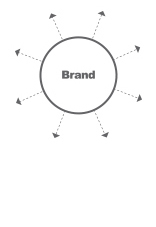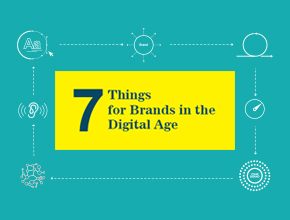Your brand is a living, breathing organism. Or at least it should be. Far more than a logo or a cheesy mission statement that you have buried somewhere on your website, your brand is what you believe about your company…and what the public thinks about your company.
That’s right: you are not 100 percent in control of your brand. But you are in control of how you promote it. You are responsible for monitoring it, tweaking it, honing it, and polishing it. And in the digital age, where customers are analyzing your brand 24/7 and on multiple channels and devices, you better be.
Is your brand standing strong? Here are 7 things you may want to reconsider.
 1. Your brand’s look
1. Your brand’s look
How consistent is your brand? The elements used on all visual components – from your website to your e-newsletter, your Facebook masthead to a sales sheet – need to work as one. Especially if you have different teams working on different materials, a brand identity that includes fonts, colors, graphics, layout, and more can make a huge impact. We’ve all judged a book by its cover as we scroll through Amazon – and consumers will be just as quick to label your brand.
On the flip side, don’t rebrand simply because you are craving the new. Customers often identify with a logo or brand image, and a change can feel abrupt and insulting. Remember how badly shoppers responded to Gap’s new logo in 2010? Probably not, because the retailer never even unveiled it after extreme backlash over the idea of revamping the iconic blue square.
 2. Your brand’s voice
2. Your brand’s voice
The language you use to describe your brand is important, and it should be consistent. You may have one person writing your website, another running your social media, and many out making face-to-face sales calls, but every one of them should be saying the same thing. Your brand’s approach, tone, and messaging should be clearly defined and understood by anyone who speaks on behalf of it. This voice represents your brand and what it stands for. And it should be loud – or at least active. Digital conversations about your industry and brand are happening around the clock – be a part of that conversation. Connect with customers on an individual, personal level, and your brand begins to feel human, too.
Take pancake giant IHOP, who was recently looking to skew younger and attract high school and college diners into their booths. The brand took to Twitter, the social handle most highly associated with that age group, and loosened its corporate tie considerably, starting with the simple tweet “Pancakes on fleek.” The reaction? More than 27,000 retweets, an increased following of 18 percent, and an article in AdWeek.
 3. Your brand’s listening skills
3. Your brand’s listening skills
There’s a difference between hearing and listening. Social media has provided brands with a remarkable opportunity to not only constantly receive marketing feedback, but to instantly react to it. Monitoring your brand’s mentions is only the start. Respond! Use that voice you’ve honed to connect, understand, and really listen to your target market. Be open enough to realize when their complaints are right – and fix them if you can.
Going a step further, a survey by Simply Measured showed that 30 percent of brands have a dedicated customer service handle on Twitter for just these opportunities. Nike’s @nikesupport handle has sent 14 times more tweets than the standard @nike handle, all in the name of quality service.
 4. Your brand’s agility
4. Your brand’s agility
A digital age equals constant change. While that means new technology and platforms to quickly learn and adapt to, it also means your customers have become moving targets. You can’t slow down their speed of online surfing, but by creating a unified digital web of brand experiences, you can surround them with a strong, consistent message. Your marketing and advertising approach need to be nimble and diverse, ensuring the right call to action is placed before the right individual, all at the right time.
 5. Your brand’s performance
5. Your brand’s performance
Think of digital advertising as the sprint and hard copy advertising the marathon. Thanks to almost-instant metrics and analytics available with digital placements, you can live-test campaigns and learn from them, creating custom promotions for various customers and platforms they frequent. And the knowledge you gain online should be translated to print and TV branding – while the venues are different, the target isn’t, and a failed message in one area is something you probably don’t want plastered on an un-editable billboard for the next three months.
Don’t forget it could be the smallest details that make the biggest impact on an ad’s performance. Online food delivery service Seamless ran a split test with half the ads picturing a Greek salad, the other a crispy grilled cheese and fries, with all other copy and offers identical. Allstate Insurance ran a similar test with the different versions calling out different competitors in the headlines. It only takes a few days to know which way is the right way to go, and the impact can be huge; proper testing can increase conversion rates by 300 percent.
 6. Your brand’s ecosystem
6. Your brand’s ecosystem
Now here’s the part where things get really interesting. In the digital age, you need to approach your brand as an ecosystem, a mesh network of interconnected and interacting channels that delivers the right message on the right device to the right person at the right time. The ecosystem enables brand marketers to make the best possible decisions to amplify audience engagement by following the customer journey and positively influencing their actions. Simply put, interactive marketing is a success not only when you choose the right channel, but when you find a way to make many channels work together.
The cycle can get even more exciting and impactful when conducted in real time — imagine connecting with a prospect on Twitter, sending them a custom microsite designed just for their interests, monitoring their interactions with that link, and following up exactly when you know they have finished viewing. With strong touchpoints and modern ecosystem monitoring programs like our Brand Ecosystem Platform, it just all starts with a few taps on the tablet.
 7. Your brand’s use of digital
7. Your brand’s use of digital
The digital world may be daunting at times, but it offers up a host of opportunities past marketers could only dream of. The various platforms through which brands and customers can connect and engage are the perfect stage for brand stories – emotionally driven and content-strong messages that can showcase your brand in ways never before possible. Creativity can abound in such a space, where 140 characters can turn into a video, into a meme, into a TV campaign, into an article, and back into a Facebook post. The only thing more plentiful than the possibilities is the data you can draw from it.

COMMENTS